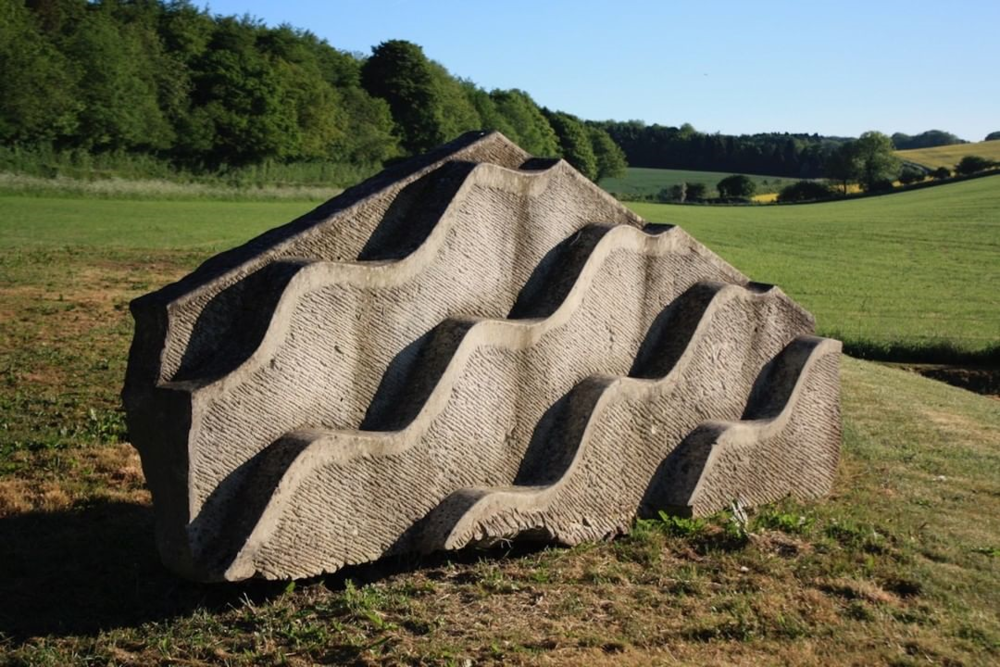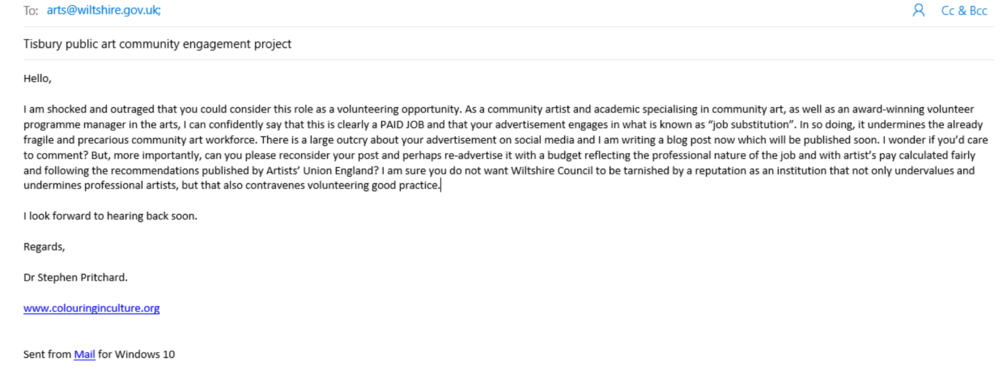Community artists as free labour: Why Wiltshire Council's "volunteer community artist" is an exploitative example of job substitution
This article is my response to the shocking “artist brief” recently published by Wiltshire Council asking for a “volunteer community artist” to do what is clearly a paid piece of work. It’s an example of the increasingly commonplace substitution of properly paid work for artists with free labour dressed up as volunteering. As such it undermines both the fragile arts economy and the reputation of volunteering.

Silent Rhythm by Tim Harrisson in situ at Messums Wiltshire sculpture garden.
Community artists as free labour: Why Wiltshire Council's "volunteer community artist" is an exploitative example of job substitution
Wiltshire Council is looking for “volunteer community artist/s to engage with primarily children and young people … to explore their creativity and using Tim Harrisson’s Silent Rhythm sculpture at the Nadder Centre … as a source of inspiration.”
The problem is that the council’s own role description makes it patently clear that they are looking for a volunteer to do a project that obviously should be paid work! It is totally unacceptable for a local council to undermine freelance artists’ jobs in this way and to misuse volunteering against all best practice guidance. There has been a backlash on Twitter and Facebook. See, for example, here and here.
The “artist brief” explains that the project began as “a public art contribution from C G Fry and Son Ltd” which led to the council “working with Messums Wiltshire”. The council say they “commissioned the ‘Silent Rhythm’ sculpture by local artist Tim Harrisson” but it was made by the artist in 2001 and has resided in Messums “sculpture garden” until it was moved to the new centre (described as a “vibrant community hub”) in 2019. It is unclear if it was purchased, donated or loaned. The sculpture was shown in 2018 at Messums Wiltshire as part of an exhibition of Harrisson’s works called ‘As It Was Is Now’.
The commissioned “volunteer community artist” is expected to “focus and draw upon the newly installed sculpture” and other artworks on display at Messums Wiltshire, thereby offering “creative inspiration”. The “chosen” artist/s are expected to have “a good history of inspirational work with children and young people that is rooted in participatory arts principles” and undertake “a series of participatory arts workshops” as well as “up to three visits per school, one with the school cohort to Messums and 2 visits to the school to engage with the pupils”. The artist/s are “expected” to “flexibly … deliver” the “project” over several months (March and July 2020), and to “work closely” the council’ Arts Lead and Community Engagement Manager during this period.
The council lists the following “key requirements” for the community artist are as follows:
Quality and integrity of process, production and delivery of high-quality arts projects; Imagination and innovation in engagement practice; A background in working with communities particularly with children and young people of pre-school and primary school age; Significant experience of inspirational work that is rooted in participatory arts principles participatory practice, especially with children and young people; Up to date DBS clearance; Public liability insurance.
These are clearly the requirements of this role are those of an experienced, professional community artist. Furthermore, given that the council claims that this is a volunteer role, it is not the responsibility of volunteers to have public liability insurance. Rather, it the responsibility of the volunteering opportunity provider (in this case, the council) to provide adequate public liability and employer liability insurance, not the volunteer. To expect this, and to expect a volunteer have already have their own DBS clearance, is a clear illustration of the fact that Wiltshire Council expects a professional community artist to work for free, not volunteer. To do so is to knowingly substitute paid work for working for free. This is known as “job substitution” and is against good employment practice and against volunteering best practice.
Also, to state that there is only a “small budget … for materials and transportation for school visits to Messums Wiltshire” is unfair on a volunteer because it is common practice to ensure volunteers are “not out of pocket” in terms of expenses incurred during volunteering. Therefore, all travel and subsidence expenses should be covered, if this is indeed a volunteering role. It is clearly not, of course. But these inconsistencies highlight an incredibly degree of unprofessionalism on the part of Wiltshire Council and its Arts Team!
The council also expects applicants to outline their intended approach, give experience of “recent experience” of similar projects and a materials costing, and include a CV and biography as well as images of previous work and links to website(s). But that’s not all. This information also extend to describing “ideas for the creative sessions” and an explanation of how the artist’s “abilities, skills and experience are suited to deliver this project”. This is a job application, isn’t it?
It is also worth noting that Helen Birchenough is a director of Messums Wiltshire – the project partner for this commission. She is also chair of Arts Council South West, a member of Arts Council England National Council, a trustee of Arts Council England National Portfolio Organisation Wiltshire Creative and Deputy Lieutenant of Wiltshire. Helen has been approached for comment via social media but has not yet responded. Given her many respected roles, it would seem difficult for Helen to support Messums’ partnership with Wiltshire Council on this particular project. Similarly, Wiltshire Council had not responded to my email at the time of writing.

This case is a bad example of an all-too-common practice within arts and culture in the UK. To expect paid professional work – in this case, the work of a community artist – to be offered unpaid and as a volunteering opportunity, is to intentionally undermine the already fragile and precarious labour market within the sector. Volunteering can be a very positive and mutually beneficial experience, but it must never be used as a trojan horse for worker exploitation and voluntarism. Community artists have struggled for professional recognition for many, many years and their work has been frequently undermined by the art world. We cannot allow a local council to flagrantly exploit community artists now or in the future. Community artists, like all professional artists, need paying for the important work they do, not asked to work for free in the guise of a “volunteer opportunity”.
